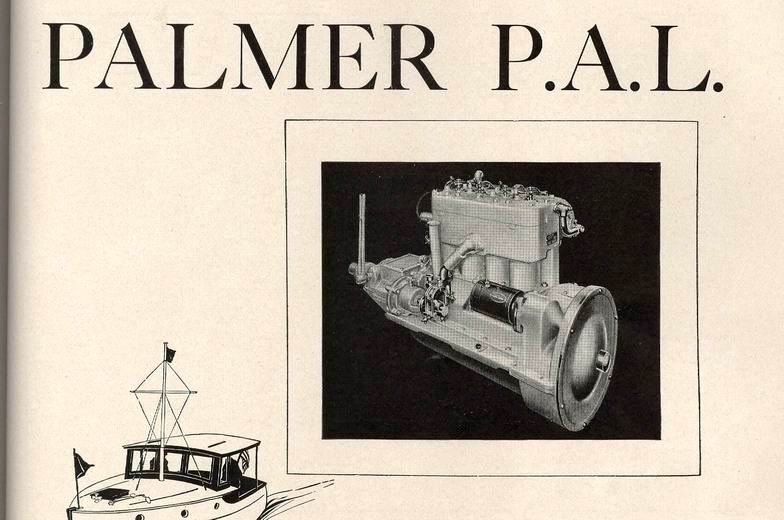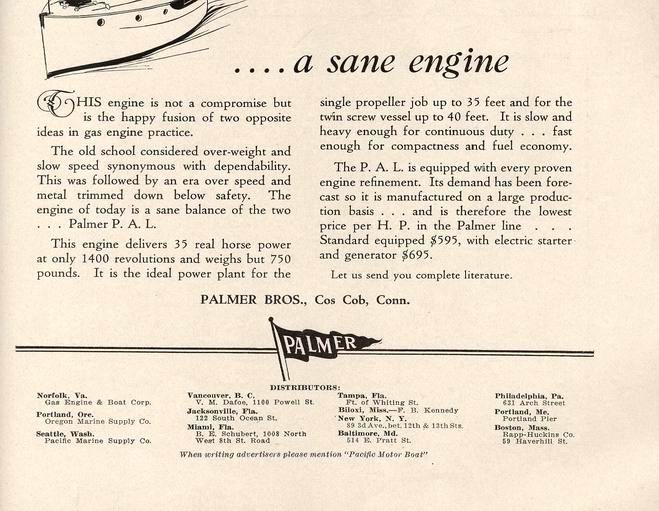|
| Author |
Message |
    
richarddurgee
Senior Member
Username: richarddurgee
Post Number: 2588
Registered: 11-2001
| | Posted on Saturday, February 19, 2011 - 08:38 pm: | 




|
*
1929
Might be A good idea to start mfging these engines again and soon, this world could use something SANE in it !


* |
    
robert
Senior Member
Username: robert
Post Number: 410
Registered: 07-2003
| | Posted on Monday, February 21, 2011 - 01:31 am: | 




|
"...followed by an era (of) over speed..." I guess it should have been. Good concept as you say Richard, and of course used up plenty of existing parts(?) Funny how Palmer felt they should replicate the old flywheel nut cover on the flywheel cover itself. |
    
richardday
Senior Member
Username: richardday
Post Number: 939
Registered: 11-2003

| | Posted on Monday, February 21, 2011 - 11:47 am: | 




|
Some thoughts regarding the Palmer PAL.
By Richard A. Day Jr. ©
02-20-2011
Starting about 1916 Palmer Bros. tried to bring out a line of small four cylinder engines for small boats in the less than 30’/40’ class. In 1916 they bought a design Palmer called the TM. This engine was an operational disaster. None are known to have survived. Cast Enblock 4 cylinder engine, 10-12 HSP 1000-1500 RPM, Bore 2¾”, Stroke 3½”, Weight 260 lbs.
In subsequent years they brought out several models which were their own designs a few were reasonably successful but by the 1930s they also began converting Ford and Hercules blocks for marine purposes. Old time employees said the conversions were a very successful product line. They also sold conversion kits which owners could bolt on to their own engine.
In 1919 Palmer Bros. hired Julius Ulrich as chief engineer and designer. His first design was the YT-1, 1921 soon followed by the YT-2, VH and VHL in 1923.
The VH 14 HSP and VHL 20 HSP were High speed, Rotary cam, Valve in Head, Cast Enblock, four cylinder, 1000-1200 RPM, VH 3”Bore 4½” Stroke VHL 3½” Bore
4½ Stroke. Neither engine design was very successful due to serious lubricating oil problems with the overhead rotary cam drive gearing. The VHL about 1930 disappear from Palmer engine catalogs. The VH and the YT-2 have disappeared from Palmer Catalogs by 1928.
The LH appears in 1928. 4 cylinder L head 3” Bore, 4” Stroke, 1000-1500 RPM
375 lbs. 10-18 HSP. Disappears about 1939. There is one known 1928 LH.
The HH appears about 1928. 2 Cylinder, L head, 3” Bore, 4” Stroke, 700-900 RPM, 280 lbs. Remained in production up into the 1950s. 10 known survivors earliest 1931 latest 1954.
The PAL appears about 1928 and disappears about 1938. No known survivors.
The LLH came out about 1930 and remained in production up until 1945. During WWII Palmer Bros. built approximately 3,000 for War Production Board for use in lifeboats on ships being built for the WWII effort. Some changes on some production was required. Most did not have electric starters. Hand crank and magnetos were typical. A few had electric starter and generators.
The LLH was, 4 cylinder L head, 3¼” Bore, 4” Stroke, 1000-1800 RPM, 475 lbs.
There are 4 known surviving LLH, 1940, 1943, 1944 and 1945. It is not known if the Liberty Ships, Obrien and Brown have their original lifeboat engines.
In the early 1930s Palmer Bros. brought out a number of larger engines none of which were a big success except for marine conversions. Few seem to have survived outside a few in museums or in private collections.
In my opinion one of the most interesting engines of the 1938/41 period is their
Palmer designed diesel using the Russell Newbery UK valve license. They tooled and started production in 1940 for the RND-1 for compressor, pumps, and generators. For propulsion the RND 4, 40 HSP, 4⅛” bore, 6” stroke, 300-1200 RPM, 2500 lbs. and
RND-6 same bore/stroke etc. 3200 lbs.
It is interesting today in London, UK the same piston/valve design RND engines are still operating in the canal boats with the cleanest burning exhaust for diesel engines. There are three known surviving RND-1 engines and possibly one or two known wrecks.
These were not light weight engines. The RND-1 weighs 900 lbs. 9 HSP at 1000 RPM.
WWII killed the Palmer RND engine production. After WWII Palmer assembled a few from prewar stocks. The surplus 671 diesel was being sold at almost give away pricing and that sealed the fate of the RND. |
    
packrat
Member
Username: packrat
Post Number: 7
Registered: 06-2009
| | Posted on Monday, February 21, 2011 - 01:49 pm: | 




|
Hello
I have a 1947 Palmer PH-47 .. If you type in theoutboardertim on YouTube it will come up .. I found it in Ohio |
|
|
|


|


